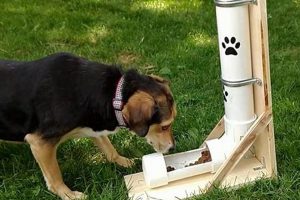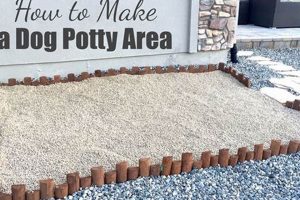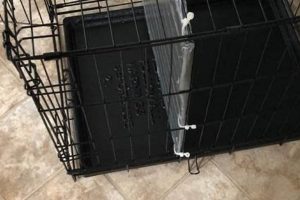Structures designed to aid canines in accessing elevated surfaces, such as furniture or beds, which they may be unable to reach independently, are frequently constructed by pet owners. These assistive devices typically consist of a series of steps, allowing smaller or mobility-impaired dogs to navigate vertically with greater ease and reduced strain. A common example includes a handcrafted set of steps leading to a bed, enabling a dachshund to ascend without jumping.
The construction of such aids offers numerous advantages. These include promoting joint health in aging animals, preventing potential injuries from jumping, and fostering a sense of independence and accessibility for pets within their home environment. Historically, pet owners have adapted household items to serve this purpose; however, dedicated designs have gained popularity with increased awareness of canine orthopedic needs and a desire for aesthetically pleasing solutions.
The subsequent sections will explore the diverse materials suitable for building these structures, detailed construction methodologies encompassing various designs, safety considerations critical for ensuring pet well-being, and customization options for seamless integration into existing home decor.
Essential Considerations for Constructing Canine Ascent Aids
The following guidelines are crucial for ensuring the safety, stability, and usability of homemade pet stairs, promoting the well-being of the animal using them.
Tip 1: Material Selection: Prioritize durable and non-toxic materials. Solid wood or sturdy plywood are recommended. Avoid materials that splinter easily or contain harmful chemicals that could be ingested by the pet.
Tip 2: Dimensional Accuracy: Accurate measurements are paramount. Consider the dog’s size, leg length, and the height of the target surface when determining step height and depth. Inconsistent step dimensions can lead to hesitation or injury.
Tip 3: Structural Integrity: Reinforce all joints and connections. Screws, glue, and brackets should be used to create a robust structure capable of withstanding the dog’s weight and movement. Wobbling or instability poses a significant safety risk.
Tip 4: Surface Traction: Implement a non-slip surface on each step. Carpet remnants, rubber mats, or textured paint can enhance grip and prevent accidental slips or falls. Regular inspection and replacement of worn surfaces are essential.
Tip 5: Angle of Ascent: Maintain a gradual incline. A steep angle increases the risk of stumbling and places undue stress on the dog’s joints. Adjust the step depth and height to achieve a comfortable and manageable slope.
Tip 6: Stability Augmentation: Anchor the structure to the target surface or the floor. This prevents the stairs from shifting or tipping during use, particularly if the dog jumps or uses them with force. Consider using rubber feet or brackets for secure attachment.
These considerations are vital for creating a safe and effective assistive device. Prioritizing stability, proper dimensions, and non-slip surfaces will significantly reduce the risk of accidents and ensure the long-term usability of the stairs.
The final section will provide recommendations on customizing and maintaining these structures.
1. Dimensions
The dimensions of canine ascent aids are paramount to their usability and safety. Incorrect sizing can render the structure ineffective or, worse, pose a hazard to the animal.
- Step Height
Step height must be carefully calibrated to accommodate the dog’s leg length. Steps that are too high can cause strain and discourage use, while steps that are too low may be inefficient and necessitate an excessive number of steps. The breed and age of the dog are primary determinants of optimal step height. For example, a dachshund requires significantly lower steps than a Labrador.
- Step Depth
Step depth, or the horizontal surface area of each step, is equally critical. Insufficient depth can cause the dog to feel unstable and hesitant, while excessive depth can make the structure unnecessarily bulky. The dog must have adequate space to place its paws securely on each step. A general guideline is to ensure the step depth is at least equal to the length of the dog’s paw from toes to heel.
- Overall Width
The overall width of the structure should provide sufficient room for the dog to ascend and descend comfortably without feeling constricted. A width that is too narrow can cause anxiety and increase the risk of falling. The size of the dog should be the primary consideration when determining the appropriate width. Larger breeds require wider steps to ensure stability.
- Incline Angle
While not a direct measurement of a single step, the overall incline angle, influenced by the interplay between step height and depth, is a critical dimensional consideration. A steep incline angle can be difficult for dogs with limited mobility or joint problems. A shallower angle provides a more gradual ascent and reduces strain. The target surface height and available floor space are key factors in determining the optimal incline angle.
These dimensional considerations collectively contribute to the safety, accessibility, and usability of canine ascent aids. A thorough understanding of these principles is essential for constructing a structure that effectively meets the needs of the individual dog and promotes its well-being. Prioritizing accurate measurements and careful planning will minimize the risk of injury and ensure that the stairs are a valuable asset for the pet.
2. Stability
The structural integrity, or stability, of handcrafted canine ascent devices directly influences their safety and effectiveness. Instability introduces the risk of collapse, tipping, or wobbling, potentially causing injury to the animal using the stairs. This risk is magnified in the presence of larger dogs or those with pre-existing musculoskeletal conditions. The materials employed in construction, the method of assembly, and the overall design contribute to the stability of the finished product. For instance, stairs constructed from thin plywood and secured with insufficient fasteners are prone to failure under load, whereas a robust frame constructed from solid wood and reinforced with appropriate joinery exhibits greater resistance to deformation.
The practical significance of stability extends beyond the immediate risk of injury. An unstable structure may cause hesitation or anxiety in the dog, discouraging its use. This negates the intended benefit of providing easier access to elevated surfaces. Furthermore, ongoing instability leads to accelerated wear and tear, reducing the lifespan of the stairs. A dog repeatedly using unstable stairs may develop compensatory movement patterns, potentially exacerbating existing joint problems or creating new biomechanical imbalances. Therefore, selecting appropriate materials and employing sound construction techniques are critical for ensuring the long-term functionality and safety of pet stairs.
In conclusion, the stability of animal-assisted ascent devices is not merely a desirable attribute but a fundamental requirement. Prioritizing a robust design and utilizing durable materials mitigates the risk of injury, promotes consistent use, and extends the lifespan of the structure. The challenges associated with achieving optimal stability can be addressed through careful planning, precise execution, and a thorough understanding of basic structural principles. These principles are essential for effective craftsmanship.
3. Materials
The selection of appropriate materials is fundamental to the successful creation of canine ascent aids. Material characteristics directly impact the structure’s stability, durability, aesthetics, and, most importantly, the safety of the animal utilizing it. Careful consideration must be given to material properties such as strength, weight, toxicity, and surface texture.
- Wood
Wood is a frequently employed material due to its relative strength, workability, and aesthetic appeal. Hardwoods, such as maple or oak, offer superior durability compared to softwoods, such as pine. However, softwoods are often more cost-effective and easier to cut and shape. Regardless of the species, wood must be properly sealed to prevent moisture damage and splintering, both of which pose risks to the animal. Formaldehyde-free plywood is a suitable alternative, offering structural integrity without the potential for harmful emissions. Scrap lumber presents an economical option, provided it is free from nails, screws, or other hazardous debris.
- Carpet & Fabric
Carpet or fabric is commonly used to cover the steps, providing traction and cushioning. Low-pile carpet or durable fabric remnants are suitable choices. Synthetic materials offer resistance to staining and moisture, while natural fibers provide a softer texture. Secure adhesion is crucial; staples, tacks, or strong adhesives are necessary to prevent slippage or detachment, which could create a tripping hazard. The chosen material should be easy to clean and maintain, as pet-related debris is inevitable.
- Fasteners & Adhesives
The integrity of the constructed piece relies heavily on the selection of appropriate fasteners and adhesives. Screws provide superior holding power compared to nails and are recommended for structural connections. Wood glue, applied in conjunction with screws, enhances joint strength. Non-toxic adhesives are essential, particularly if the pet is prone to chewing or licking the structure. Select fasteners that are flush with the surface to prevent injury or snagging.
- Support Structures
Depending on the design, additional support structures, such as metal brackets or corner braces, may be necessary to enhance stability. These components reinforce joints and prevent racking, particularly in taller or wider structures. Rubber feet or non-slip pads applied to the base of the stairs provide additional stability and prevent damage to flooring. The material selection for support structures should complement the overall design and ensure compatibility with other chosen materials.
The interplay of these material considerations directly affects the long-term performance and safety of handcrafted pet stairs. Selecting high-quality, non-toxic materials and employing sound construction techniques minimizes the risk of injury and ensures that the structure effectively meets the needs of the animal. This process demands meticulous planning and careful execution.
4. Surface
The surface characteristics of canine ascent aids are critical to their functionality and safety. The ideal surface provides sufficient traction to prevent slips and falls, while also being comfortable and durable enough to withstand repeated use. An inadequate surface can render the stairs unusable or even dangerous, particularly for elderly or mobility-impaired animals.
- Material Selection and Traction
The choice of material directly impacts the surface’s traction. Smooth surfaces, such as bare wood or plastic, offer minimal grip and are prone to causing slips. Conversely, textured surfaces, such as carpet, rubber, or non-slip paint, provide enhanced traction. The specific material should be selected based on the dog’s size, weight, and activity level. For instance, a larger dog may require a more durable and aggressively textured surface compared to a smaller, less active breed.
- Surface Texture and Paw Sensitivity
The texture of the surface must be carefully considered to avoid irritation or discomfort to the dog’s paws. Abrasive or rough surfaces can cause chafing or even injury, particularly to sensitive paws. A balance must be struck between providing adequate traction and ensuring a comfortable surface. Low-pile carpet, textured rubber mats, or paint with a fine aggregate additive are common solutions that offer a compromise between grip and comfort.
- Maintenance and Cleanliness
The surface material should be easy to clean and maintain to prevent the build-up of dirt, debris, or pet dander. Regular cleaning is essential to maintain traction and hygiene. Absorbent materials, such as thick carpet, can trap moisture and odors, requiring more frequent and thorough cleaning. Non-absorbent materials, such as rubber or vinyl, are easier to wipe clean and are less prone to harboring bacteria.
- Durability and Wear Resistance
The surface material must be durable enough to withstand repeated use and resist wear and tear. Thin or flimsy materials can quickly wear through, exposing the underlying structure and creating a potential hazard. Durable materials, such as commercial-grade carpet or reinforced rubber, offer greater resistance to abrasion and tearing, extending the lifespan of the stairs.
These surface considerations collectively determine the overall safety and usability of canine ascent aids. A well-chosen surface provides secure footing, promotes comfort, and ensures the long-term functionality of the structure, thereby enhancing the dog’s quality of life. A poorly chosen surface can lead to injury and aversion to the structure, negating its intended benefits.
5. Angle
The incline angle of canine ascent aids is a critical design parameter that significantly influences the ease and safety with which a dog can utilize the structure. The angle, formed by the relationship between step height and step depth, directly impacts the physical exertion required for each step and the overall stability of the animal during ascent and descent.
- Impact on Joint Stress
A steeper angle necessitates greater flexion of the hip, knee, and ankle joints with each step. This increased joint flexion can exacerbate existing conditions such as arthritis or hip dysplasia, causing pain and discomfort. Conversely, a shallower angle reduces joint stress, allowing for a more fluid and comfortable movement pattern. The ideal angle is contingent upon the dog’s breed, age, and any pre-existing musculoskeletal issues. For example, a dog with severe arthritis would benefit from a very shallow angle, even if it requires a larger overall footprint for the structure.
- Influence on Stability and Balance
A steeper incline angle reduces the dog’s stability and balance, increasing the risk of stumbling or falling. The center of gravity is shifted forward, requiring greater muscular effort to maintain equilibrium. This is particularly problematic for smaller breeds or those with neurological deficits. A shallower angle provides a wider base of support and a lower center of gravity, enhancing stability and reducing the likelihood of accidents. The presence of non-slip surfaces becomes even more crucial at steeper angles to compensate for the reduced stability.
- Relationship to Step Dimensions
The angle is inextricably linked to the step height and step depth. A fixed target surface height requires a trade-off between these two dimensions to achieve a desired angle. Smaller step heights necessitate a greater number of steps to reach the target surface, resulting in a shallower angle. Conversely, larger step heights reduce the number of steps but increase the angle. The optimal combination of step height, step depth, and angle should be determined based on the dog’s individual needs and physical capabilities. A step-by-step approach to planning is advised.
- Considerations for Different Dog Breeds
Different dog breeds possess varying anatomical characteristics that influence their ability to navigate inclines. Brachycephalic breeds (those with shortened snouts) may experience respiratory distress at steeper angles due to increased exertion. Long-backed breeds, such as dachshunds, are particularly susceptible to spinal injuries and require shallower angles to minimize stress on their intervertebral discs. Consideration of these breed-specific factors is essential for designing ascent aids that are both safe and effective.
In summary, the angle of handcrafted canine ascent devices is a pivotal design element that impacts joint health, stability, and overall usability. Careful consideration of the dog’s individual needs, anatomical characteristics, and any pre-existing medical conditions is paramount to determining the optimal angle. Prioritizing a gradual incline and appropriate step dimensions will ensure that the structure provides a safe and comfortable means of accessing elevated surfaces, enhancing the dog’s quality of life.
6. Durability
The longevity and resilience, collectively termed durability, represent a critical attribute of canine ascent aids. Durability dictates the lifespan of the structure and its capacity to withstand consistent use by animals of varying sizes and activity levels. A lack of durability translates to structural instability, premature wear, and an elevated risk of component failure, thereby compromising the safety of the animal. For example, stairs constructed from inadequately treated softwood may succumb to splintering or structural collapse within a short timeframe, posing a potential hazard. The durability of these devices is therefore not merely a matter of economic consideration but a fundamental aspect of animal welfare.
The selection of materials, construction techniques, and protective finishes directly affects the durability of the finished product. Employing robust hardwoods, implementing reinforced joints, and applying weather-resistant coatings contribute to increased longevity and resistance to damage. A well-constructed set of pet stairs, designed with durability as a primary consideration, can provide years of reliable service, minimizing the need for costly repairs or replacements. Conversely, shortcuts taken during the construction phase, such as using inferior materials or neglecting proper assembly, invariably result in a diminished lifespan and an increased risk of failure. An example of this might include omitting proper surface preparation or sealant application to the wood, leading to rot and decay of the structure upon contact with environmental moisture.
In conclusion, durability is an indispensable characteristic of canine ascent aids, impacting both their economic value and, more importantly, the safety and well-being of the animal using them. Prioritizing robust construction methods and durable materials is paramount to ensuring the long-term functionality and safety of these structures. Addressing concerns about the durability of manufactured stairs through careful planning and design ensures the final product is a long-lasting and reliable asset for the pet’s comfort.
Frequently Asked Questions
The following addresses common inquiries regarding the construction, safety, and suitability of handcrafted canine ascent aids. These responses aim to provide clarity and ensure responsible building practices.
Question 1: What constitutes a safe incline angle for canine stairs?
The incline angle must be gradual to minimize joint stress. A steep incline increases the risk of stumbling and is particularly unsuitable for dogs with arthritis or hip dysplasia. The angle should ideally be less than 30 degrees, contingent on the dog’s individual needs.
Question 2: Which materials are unsuitable for constructing canine stairs?
Materials that are prone to splintering, such as untreated softwood, or those containing toxic chemicals should be avoided. Unstable materials, like thin cardboard, offer inadequate support and pose a significant safety risk.
Question 3: How is structural stability ensured?
Structural stability is achieved through robust construction techniques and the use of appropriate fasteners. Screws and glue provide superior holding power compared to nails. Reinforcing joints with brackets enhances stability, particularly for larger structures.
Question 4: What surface treatment is recommended to prevent slippage?
The application of non-slip materials is crucial. Carpet remnants, rubber mats, or textured paint enhance grip and prevent accidental falls. Regular inspection and replacement of worn surfaces are essential.
Question 5: How does the size and weight of the dog influence the design?
Larger and heavier dogs require sturdier materials and wider steps to ensure stability. Step height and depth must be adjusted to accommodate the dog’s leg length and stride. The overall structure must be capable of supporting the dog’s weight without deformation.
Question 6: What maintenance is required to ensure the longevity of canine stairs?
Regular inspection for loose fasteners, worn surfaces, or structural damage is essential. Cleaning the surface to remove dirt and debris maintains traction. Prompt repair of any damage prevents further deterioration and ensures continued safety.
In summary, careful planning, appropriate material selection, and sound construction techniques are paramount to creating safe and effective pet stairs. Prioritizing stability, proper dimensions, and non-slip surfaces will significantly reduce the risk of accidents.
The next section will address customization options.
Conclusion
The preceding analysis explored various facets of “diy dog stairs,” emphasizing the importance of safety, stability, and appropriate design. Key considerations included material selection, dimensional accuracy, surface traction, and incline angle, all of which directly impact the usability and longevity of the structure. Adherence to these guidelines minimizes the risk of injury and ensures the creation of a valuable aid for canine accessibility.
Constructing pet stairs represents a commitment to animal well-being. By prioritizing structural integrity and carefully considering the individual needs of the animal, pet owners can create customized solutions that enhance their companion’s quality of life. Future endeavors in this area should focus on innovative designs and materials that further improve safety and accessibility, solidifying the role of “diy dog stairs” as a proactive solution for canine care.







